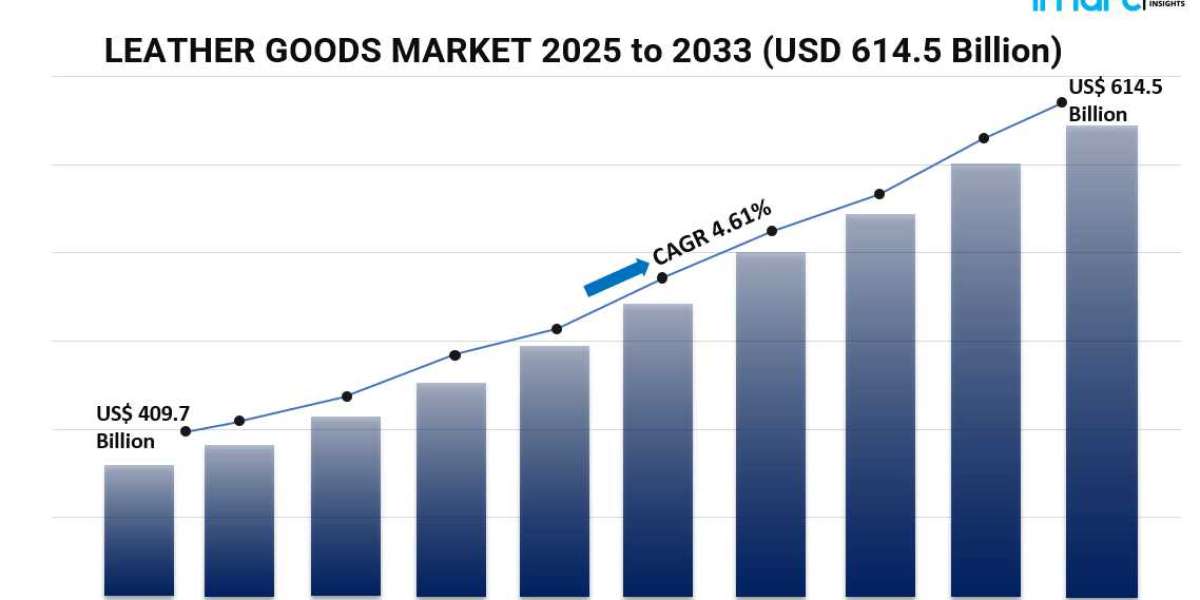Leather Goods Market Overview
The global leather goods market reached a size of USD 409.7 billion in 2024 and is expected to climb to USD 614.5 billion by 2033, expanding at a CAGR of 4.61% between 2025 and 2033. Growth in this market is driven by several key factors, including increasing disposable income, rising consumer demand for luxury and premium products, advancements in production technologies, and the evolution of fashion trends. Furthermore, the growing adoption of sustainable materials and the strengthening role of e-commerce platforms are providing fresh momentum to market expansion.
Study Assumption Years
- Base Year: 2024
- Historical Years: 2019–2024
- Forecast Years: 2025–2033
Leather Goods Market Key Takeaways
- In 2024, the market size stood at USD 409.7 billion and is projected to reach USD 614.5 billion by 2033, registering a 4.61% CAGR.
- Footwear remains the leading product segment, with durable and stylish leather shoes driving strong demand.
- Genuine leather dominates the material category, valued for its quality and longevity.
- The prominence of premium products highlights the increasing inclination toward luxury leather merchandise.
- Online retail platforms are gaining traction as a vital distribution channel due to convenience and product variety.
- North America continues to lead globally, supported by strong luxury spending patterns.
- Rising awareness of sustainability is pushing demand for eco-friendly and vegan leather alternatives.
Request for a sample copy of this report: https://www.imarcgroup.com/leather-goods-market/requestsample
Market Growth Factors
Rising Disposable Income and Luxury Spending
Increasing incomes in emerging economies are significantly influencing purchasing behavior. Consumers in countries such as India, China, and Brazil are investing more in premium and high-end leather products, viewing them as a mark of sophistication and status. This growing middle-class affluence is directly boosting global market growth.
Technological Innovations in Production
The adoption of digital design systems, automated stitching, and 3D printing is transforming leather manufacturing. These innovations enhance durability, customization, and efficiency, enabling companies to cater to consumer preferences for personalized and luxury goods.
Sustainability and Ethical Sourcing
With consumer demand shifting toward eco-conscious products, the leather industry is adopting bio-based, vegan, and ethically sourced alternatives. Transparency in supply chains and sustainable production practices are becoming essential for brands aiming to attract environmentally responsible buyers.
Market Segmentation
Breakup by Product
- Footwear:
- Military Shoes
- Casual Shoes
- Formal Shoes
- Sports Shoes
- Others
- Leather Products:
- Upholstery
- Luggage
- Accessories
- Clothing and Apparel
- Bags, Wallets, and Purses
- Others
Breakup by Material
- Genuine Leather:
- Top-grain Leather
- Split-grain Leather
- Synthetic Leather:
- PU-Based Leather
- PVC-Based Leather
- Bio-Based Leather:
- Plant-derived eco-friendly alternatives
Breakup by Price
- Premium Products
- Mass Products
Breakup by Distribution Channel
- Clothing and Sportswear Retailers
- Departmental Stores
- Supermarkets and Hypermarkets
- Online Stores
- Others
Breakup by Region
- North America (United States, Canada)
- Asia Pacific (China, Japan, India, South Korea, Australia, Indonesia, Others)
- Europe (Germany, France, United Kingdom, Italy, Spain, Russia, Others)
- Latin America (Brazil, Mexico, Others)
- Middle East and Africa
Regional Insights
North America leads the global leather goods industry, benefiting from strong consumer spending on luxury items and the presence of globally recognized brands. A well-established retail structure and growing emphasis on sustainable and ethical production further reinforce its position. Fashion trends and celebrity endorsements continue to shape purchasing behavior in this region.
Recent Developments News
- In 2024, Adidas launched a sustainable sneaker line crafted with eco-friendly leather, reflecting its commitment to innovation and green initiatives.
- American Leather Holdings LLC rolled out an exclusive collection of artisan-crafted leather accessories aimed at high-end consumers.
These examples highlight the market’s shift toward combining traditional craftsmanship with sustainable practices to meet evolving customer expectations.
Key Players
- Adidas AG
- American Leather Holdings LLC
- Capri Holdings Limited
- Hermès International S.A.
- Kering S.A.
- LVMH
- Prada S.p.A. (Prada Holding S.P.A)
- Puma SE
- Tapestry Inc.
- VIP Industries (Piramal Group)
- Woodland (Aero Group)
If you require any specific information that is not covered currently within the scope of the report, we will provide the same as a part of the customization.
Ask Analyst for Customization: https://www.imarcgroup.com/request?type=reportid=2346flag=C
About Us
IMARC Group is a global management consulting firm that helps the world’s most ambitious changemakers to create a lasting impact. The company provides a comprehensive suite of market entry and expansion services. IMARC offerings include thorough market assessment, feasibility studies, company incorporation assistance, factory setup support, regulatory approvals and licensing navigation, branding, marketing and sales strategies, competitive landscape and benchmarking analyses, pricing and cost research, and procurement research.











